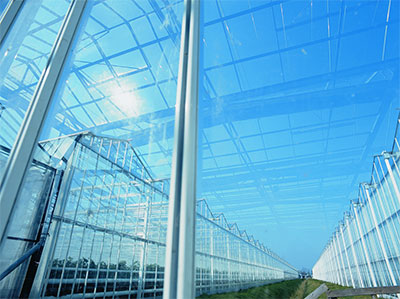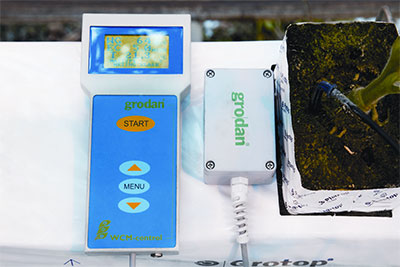
In the summer, adjustments to the start and stop times of irrigation and the use of stable EC settings are required.
 |
|
| Photo 1: High light and high temps can also bring high humidity. Photos courtesy: grodan Advertisement
|
The driving force behind water uptake is the transpiration. The biggest influencers on transpiration are light (45 per cent), humidity (35 per cent), and temperature (10 per cent). Big differences can be seen in transpiration and water uptake between different growing regions of the world with similar light levels, all due to the differences in humidity.
Regions with lower humidity show more transpiration compared to regions of high humidity. Therefore, just giving water in summertime isn’t always good; we still need to pay attention to the rate of transpiration to manage water content (WC) and EC correctly so that plant stresses are minimized.
There are different tools/parameters to look at – for example, plant temperature and water content.
Influence of light and humidity: In many areas of the world we would normally associate high light and high temperatures with high levels of transpiration and then target irrigation strategies accordingly. But we may under-estimate the “damping effect” of high humidity.
There are areas of the world where high light and high temperatures also bring with them high humidity. Canada, Korea, Japan and subtropical Australia are just a few examples where technicians and consultants have direct experience with these conditions.
In these cases, it is normal to experience high outside temperatures (>30 C) combined with high humidity (>85 per cent), and in such conditions, it is important to understand what is driving water uptake. Table 1.0 provides an indication of uptake versus light and how this is influenced by humidity and temperature.
 |
Table 1.0: Indicative plant water uptake (tomato) in ml/J at 2000 J/cm2 at two temperatures and high or low humidity.
In some situations, low humidity transpiration can be greater than the plant’s ability to take up water from the substrate. The plant will protect itself by closing its stomata. In these situations, the crop loses the ability to cool itself.
A moveable shade screen may be used in this situation to help the crop keep pace with transpiration and to keep plant temperatures in balance. In areas of high humidity, inside shading is not advisable as the greenhouse air exchange is reduced. This can further increase the humidity levels, leading to an unwanted reduction in transpiration. In these situations, outside shading is recommended.
Irrigation strategy: Throughout the season, but especially under the conditions of high summer humidity, we must remain conscious of the quality of the root system and the potential long-term effects of poor root health on production in the fall (autumn) if irrigation is applied too freely. Start and stop times need to be adjusted to facilitate at least an eight per cent decrease in WC overnight, and you should avoid over-supplying water during the day.
WATER CONTENT METER PROVIDES REAL TIME MEASUREMENT OF PLANT RESPONSE
To be proactive in maintaining root health, you should use the tools that are available. A water content meter provides a real time measurement of how the plant is responding to the climatic conditions imposed upon it. By looking closely at the graphics you will see at what time you should start and stop irrigation and how quickly the crop is transpiring during the day.
 |
|
| Photo 2: A water content meter by Grodan |
When this is combined with EC development and drainage figures you can make timely and accurate adjustments to the irrigation strategy.
EC management: Decreasing EC in the drip solution is normal practice in summer, i.e. 3.0 mS – 0.5mS in the range 400-700 W/m2 are “standard settings” which will suit tomato or pepper crops.
Reducing EC in response to increasing light makes it easier for the plant to transpire and avoids physiological disorders such as blossom end rot (BER). However, when outside humidity is high, the rate of transpiration will be reduced (Table 1). Under these conditions, if the drip EC is too low, the nutritional demand of the plant may not be satisfied, again leading to physiological disorders such as BER.
In situations like this, in order to realize a minimum eight per cent reduction in slab WC, your stop times would be relatively early (500 – 400 Wm2). It can also mean low EC in irrigation pipes in the morning, which then compounds the issue. In this scenario, it can be better to compromise and set a lower but stable drip EC for the entire irrigation day (2.6 – 2.8 mS).
 |
|
Following the completion of his degree in horticulture, Phil Johnson started his career as a tomato grower for VHB, the largest greenhouse producer in the U.K., managing 23 acres. In 2003, he joined Grodan as a technical sales advisor for the U.K. In 2004, he moved to New Zealand to provide the same advice and technical support for growers in New Zealand and Australia. Since 2008, he has been a crop consultant for the North American market with a focus mainly on Leamington and B.C. and specializing in propagation.
Print this page